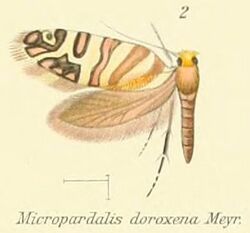Biology:Micropardalis doroxena
From HandWiki
Revision as of 19:55, 1 May 2022 by imported>CodeMe (change)
Short description: Moth species in family Micropterigidae
| Micropardalis doroxena | |
|---|---|

| |
| Scientific classification | |
| Domain: | Eukaryota |
| Kingdom: | Animalia |
| Phylum: | Arthropoda |
| Class: | Insecta |
| Order: | Lepidoptera |
| Family: | Micropterigidae |
| Genus: | Micropardalis |
| Species: | M. doroxena
|
| Binomial name | |
| Micropardalis doroxena (Meyrick, 1888)[1]
| |
| Synonyms | |
| |
Micropardalis doroxena is a species of moth belonging to the family Micropterigidae. It was described by Edward Meyrick in 1888.[2][3] It is endemic to the North Island of New Zealand.[4]
Taxonomy
In 2014 the taxonomy of this species was revised and placed within the genus Sabatinca. It is now known as Sabatinca doroxena.[4]
Description
Meyrick described the species as follows:
Female wingspan 11 mm. Head and palpi light ochreous, sides of crown brown. Antennae dark fuscous, annulated with whitish-ochreous. Thorax ochreous-brown. Abdomen dark grey. Legs dark grey, ringed with pale ochreous. Forewings oblong, costa abruptly bent near base, thence gently arched, apex round-pointed, hindmargin straight, very oblique; neuration quite as in P. chalcophanes, but 7 and 8 separate; pale shining golden; two rather narrow oblique coppery-bronze fasciæ from costa near base and at 1⁄3, confluent on inner margin before middle; a straight rather narrow whitish-purplish fascia, margined with coppery-bronze, from middle of costa to inner margin beyond middle; a whitish-purplish black-margined transverse spot from costa at 2⁄3, reaching half across wing; a black semi-annular mark, its extremities touching costa at 4⁄5 and apex, marked with three shining whitish-purplish spots, and including a spot of ground-colour which contains a black costal dot; a semi-oval black anal blotch, not marginal except at extremities, containing three shining whitish-purplish spots near lower edge, and one in a small projection on upper edge: cilia pale golden, with blackish apical, median, and anal spots. Hindwings dark purple-grey; cilia grey.[3]
Adults have a black wing margin decorated with shining silver spots and various diagonal bands. It is thought to represent a face-on view of a jumping spider. Instead of waiting motionlessly, it is thought the spider would be tempted to signal to an image of another spider, thus allowing the moth to escape predation.
References
- ↑ "NZOR Name Details - Micropardalis doroxena (Meyrick, 1888)". Landcare Research New Zealand Ltd. http://www.nzor.org.nz/names/890885a7-ff40-4f20-be25-5881aa6425f4. Retrieved 18 January 2018.
- ↑ Beccaloni, G.; Scoble, M.; Kitching, I. et al., eds (2003). "Micropardalis doroxena". The Global Lepidoptera Names Index. Natural History Museum. https://www.nhm.ac.uk/our-science/data/lepindex/detail/?taxonno=137666.
- ↑ 3.0 3.1 Meyrick, Edward (1888). "Descriptions on New Zealand Tineina" (in en). Transactions and Proceedings of the New Zealand Institute 20: 77–106. https://biodiversitylibrary.org/page/3746403.
- ↑ 4.0 4.1 Gibbs, G. W. (2014). "Micropterigidae (Insecta: Lepidoptera).". Fauna of New Zealand 72: 1–127. https://www.landcareresearch.co.nz/__data/assets/pdf_file/0007/76327/FNZ_MicropterigidaeHQ_20140630.pdf.
Wikidata ☰ Q6839803 entry

